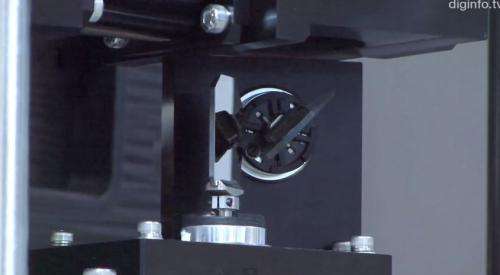June 20, 2013 weblog
Ultra high-speed camera ball-tracker at Japan lab uses mirrors (w/ video)

(Phys.org) —Ishikawa Oku Laboratory at the University of Tokyo may help transform how we can see broadcast sports events, where ball tracking reaches new heights of detail and precision. Namely, they are working on a camera system that tracks moving objects in an unusual way and, according to witnesses, unusually well.
Researchers at the Lab have been working on "dynamic image control," where high speed image processing and new optical devices and systems come into play. They have worked on focusing and pan/tilt, toward methods to capture high-speed moving targets. "Many dynamic phenomena in real world have immoderate characteristics that prevent human from clear understanding—a pattern on a flying bee wing, printed characters on a whacked golf ball dropping onto a fairway." A focus on capturing dynamic images led them to develop a camera system that tracks very fast moving objects. The key component is mirrors—working in special ways.
While conventional practice to change the direction that a camera faces was to move the camera, .the Lab solution does not move the camera; mirrors move. Their system has two mirrors for pan and tilt, and a group of lenses. "The Saccade mirrors can be controlled at high speed, on the order of milliseconds," according to a DigInfo video. "The mirrors move independently, so this system doesn't lose its high-speed response even if it's connected to a large, heavy camera."
Hiromasa Oku, a spokesperson in the video, explained how "Using a rotating mirror is a common method, but usually, the mirror is in front of the camera, so a very large mirror is needed. But a feature of this system is, it can even capture wide-angle images with a small mirror. That's because the system contains special optics called a pupil shift system."
Elsewhere the lab team has written how "We developed a high-speed gaze control system to achieve a millisecond-order pan/tilt camera. We named this system 'Saccade Mirror.'"
Their demo shows them tracking a table-tennis ball; even though the ball moves fast, the ball stays in the middle of the image. In a sports event context, their system can resolve difficulties that camera operators have in tracking their camera's direction on a dynamic object such as a player or ball. The team said the system can record, in great detail, the instant a player hits a home run, including how the bat bends and the ball reacts, and the ball's subsequent path. In soccer, the system can record penalty kicks in "amazing" detail.
To put the system to such a test, the Lab is taking the camera system out of the lab and on to playing fields, to check how well it works outdoors. They said that eventually they expect the system to be ready for broadcast.
More information: via Diginfo.tv
© 2013 Phys.org





















